
views
Meeting a New Dog

Avoid making direct eye contact with a dog you don’t know. Direct eye contact can be seen as aggressive or threatening behavior to a dog, so don’t stare directly at a dog that you’re meeting. Use your peripheral vision and make occasional glances at the dog instead of locking eyes with them to help them feel like they can trust you. Direct eye contact can really frighten sensitive dogs or dogs who may have experienced abuse in the past. If it helps, try looking at the dog’s back or neck instead of their eyes. Take a quick glance at the dog’s eyes to see if they appear glassy, which can be a sign that they feel threatened, stressed, or scared.
Approach the dog calmly and at an angle. Walk toward a dog that you’re meeting by making an arc so you approach from an angle instead of directly in front of them, which can make them nervous or feel threatened. Project calm and relaxed energy and don’t make any sudden or wild movements so you don’t freak them out. Never approach a dog you don’t know from behind either. You could frighten them or make them feel threatened. Pay attention to the dog’s body language as well, such as having their tail tucked between their legs, or if their body seems stiff, which can be a sign that they’re nervous or scared. Acting excited can make the dog excited and lead to an aggressive greeting, like jumping up on you or barking at you. This can also trigger the dog’s fight or flight instinct, as a stranger approaching the dog with high energy can feel like a threat to the dog.
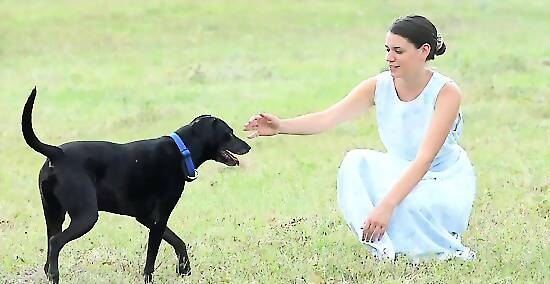
Stop about 10 feet (3.0 m) away and allow the dog to come to you. As you walk toward a dog that you’re meeting, stop and stand still a little ways away from them. Wait for them to choose to approach you so they feel more comfortable. Stay calm and relax to show the dog you can be trusted. Walking directly up to a dog you don’t know can frighten them. Try smiling and saying hello in a friendly tone to make the dog feel safe.
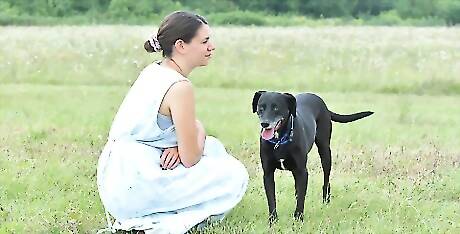
Kneel down to get on their level when they approach you. If the dog does choose to walk over to you, kneel or squat down so you’re closer to their level to show them that you’re friendly. If the dog backs away when you lower down, stay calm and wait patiently for them to decide if they want to approach you again. It’s not uncommon for a dog to be super hesitant or not want to approach you at all. If that’s the case, don’t force it. Be friendly and calm and eventually they may warm up to you.
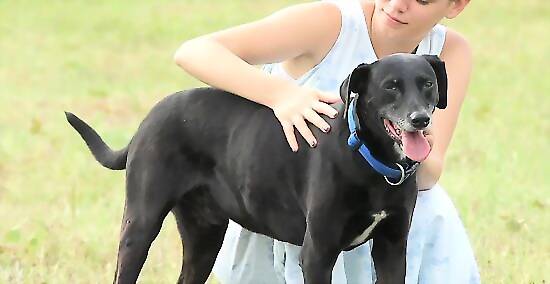
Greet and pet the dog to show them you’re friendly. If the dog trusts you enough to approach you, give them some love! Pat their head and rub their ears. Ask them who’s a good boy or girl and scratch their back. Dogs love to be loved, so say sweet things and pet them to make them happy, which will help get them to trust you. If a dog suddenly gets uncomfortable or backs away, don’t chase after them. Be patient and wait for them to come back to you, especially if you’re meeting them for the first time. You could also give the dog a tasty treat when you greet them to help them trust you.
Bonding with Your Dog

Go for a daily walk to bond with your dog and let them explore. Dogs are active animals and love to go for walks, so try to take them out at least once a day for 20-30 minutes. Let your dog use the bathroom, sniff all the smells, and feel like they’re safe with you. Some dogs may be frightened by traffic or other dogs, so avoid putting them in stressful situations as much as possible.
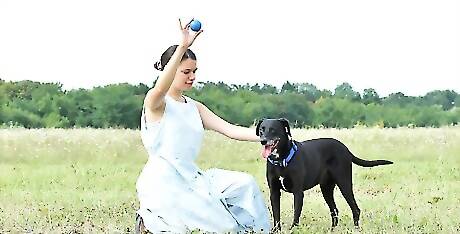
Spend at least 15-20 minutes a day playing with your dog. Spend time playing with your dog to foster a healthy and positive relationship. Throw a tennis ball around to play fetch or get some toys designed to be safe for dogs. Spend 15-20 minutes playing with your dog every day so they have fun and learn they can trust you. Look for dog toys at your local pet shop or by ordering them online. If there’s a pet store in your area that allows dogs inside, bring your dog and let them pick out their own toy!
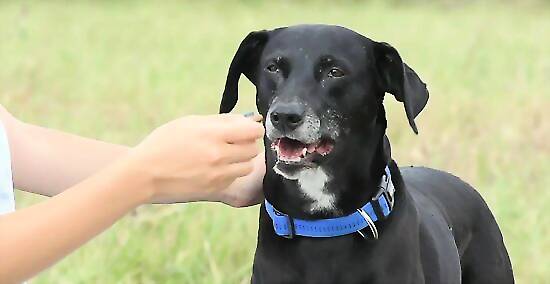
Reward good behavior to build a loving relationship. Reinforce good behavior with lots of love and positivity. Give your dog a treat whenever they do something right or listen to you. Pet your dog often to show them you love them, and if they roll over to ask for belly rubs, give them a good scratching! Modify your dog’s behavior and earn their trust by rewarding their good behavior, especially if they have aggression issues. If a dog exposes their belly to you for rubs, it’s a sign that they really love and trust you.

Cuddle with your dog so they feel safe with you. Try curling up for a nice nap with your dog on the sofa, or just hang out in bed. Let them get comfortable being around you and enjoy spending time with you. Dogs love to nap and relax, especially when they feel safe and comfortable.
Creating a Positive Environment
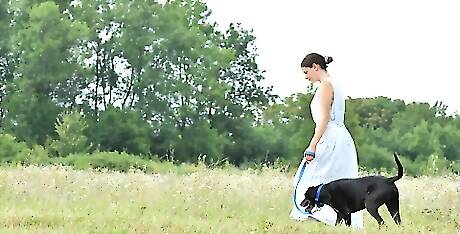
Establish a daily routine to help your dog feel more comfortable. Dogs, especially younger dogs and puppies, love consistency and routine. Establish a set feeding time so your dog learns to trust when you’ll give them food. Try to go for walks and let them outside at the same times each day so your dog knows they can depend on you. You may be surprised at how much your dog notices your daily routine and habits. Try to incorporate a routine for your dog into your daily schedule so they feel like they can rely on you. Setting routines can also help tell you if something is bothering your dog. For instance, if your dog doesn’t seem to be interested in food when their normal feeding time comes around, they could be sick or scared about something.

Avoid yelling at your dog when they misbehave. Dogs can sense your emotions and if you get angry at them, they could get scared or feel like they can’t trust you. Even if your dog does something bad, such as using the bathroom in the house or chewing up the sofa, try not to raise your voice at them. You can correct their behavior without shouting at them, and they’ll learn they can trust you, even when you’re not happy with something they did. For instance, if your dog uses the bathroom in the house, try firmly telling them, “No!” and then bring them outside so they learn that they need to do their business outside. Though there is debate surrounding the use of force to train dogs, behavioral experts argue that using forceful punishment can frighten and traumatize your dog.
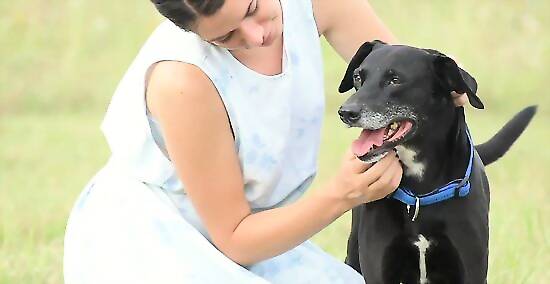
Pay attention to what your dog likes and dislikes. Watch what food your dog likes to eat or what toys they like to play with. Give them what they really want so they see you as a source of good things and want to be around you. If there’s something your dog doesn’t like, try to keep it away from them so they enjoy their environment. For instance, if your dog doesn’t like being pat on their head, then don’t pat them there! Or if they don’t like loud noises, try to keep your home quieter. Pay attention to the food your dog seems to enjoy as well as the food they don’t seem to like so you can give them what they want.
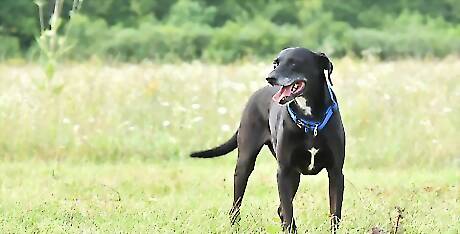
Set up an area for your dog to sleep and relax in. Choose area out of the way such as in the corner of a room or a closet to use as a sort of “den” for your dog. Place a dog bed and some toys in the area so your dog has a nice comfy spot to relax, unwind, and sleep. Dogs naturally like to curl up in a safe area when they sleep, so you can create one for them to use.
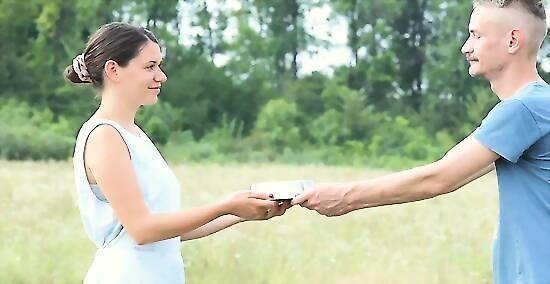
Ask family members to feed your dog if it's a rescue to help socialize it. If you have a rescue dog, have other people who live with you feed them as well so they learn to bond and trust with everyone in the home. Make your dog feel like they live in a happy place by associating everyone in the home with yummy food. For instance, if you live with children, have them feed your dog every other day or so. If you normally feed your dog, they may only learn to trust you.
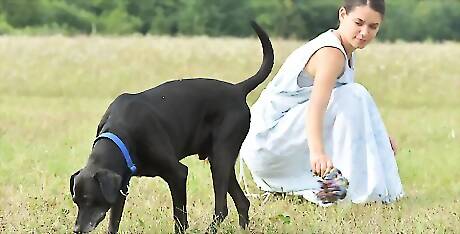
Play music and provide toys when you leave so the dog isn't lonely. Dogs don’t like to be left alone and be experience separation anxiety, especially if they’re rescues. Put on some music or the TV and make sure your dog is set up with plenty of toys to play with whenever you leave the house so they aren’t lonely. Dogs can also get bored, too. Keeping your dog occupied can help keep them out of trouble, such as digging in the trash can.
Training Your Dog
Create a stronger bond by training your dog 1-2 times a week. Develop and build a bond with your dog by training them for obedience or to do tricks. Work with your dog for at least 15 minutes a couple of times a week to build a stronger and more trusting relationship. You don’t have to do anything fancy, just head out in your backyard, go to a nearby field, or even use your living room to work on a trick or a command. Training your dog isn’t just about getting them to behave. If your dog knows what you’re trying to communicate, they’ll trust you more. If you plan to take them a dog park or an obedience course, it’s important that you establish trust between you and your dog before you enroll him in any professional training, as this will allow him to interact with other trainers and other dogs confidently and without fear.

Call your dog to you and reward them to teach them to come. Stand still in a spot and call your dog’s name or say something like, “Come” or “Here.” When your dog comes to you, give them a treat or lots of love as a reward. Keep practicing the come command and over time your dog will learn to listen to you even without getting a treat as a reward. Make training a fun game for your dog. Keep a positive attitude so your dog doesn’t feel stressed out.

Teach your dog to heel so they can go on walks safely. The heel command calls your dog to your side while you’re out on a walk by having them walk at your side. Walk around your home or backyard, call your dog’s name, and point to the side you want them to walk on. When they listen to you, give them a treat as a reward. With enough practice, your dog will be able to heel on real walks and without a reward. The heel command is really useful, especially when you’re out walking your dog near high-traffic areas.
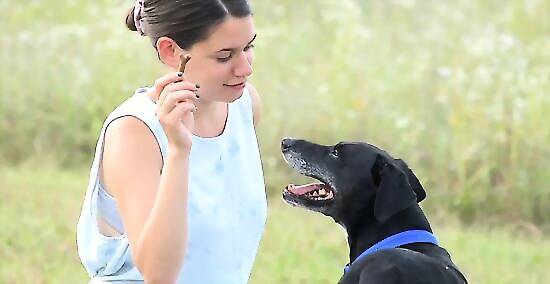
Give a treat and say “Speak” when they bark to teach the speak trick. If you want to teach your dog to speak, wait until you catch them barking and give them a treat. When you give them a treat, say “Speak” so they associate the reward and command with a bark. With some practice, your dog will learn to bark whenever you give the command. If your dog trusts you, they’ll be eager to please you. Working on fun tricks together is a great way to strengthen your bond and build trust. Teach your dog a bunch of commands and tricks to spend time together and build a strong, trusting relationship with them.















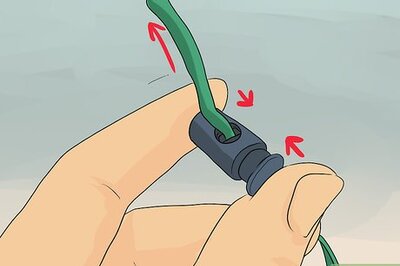




Comments
0 comment